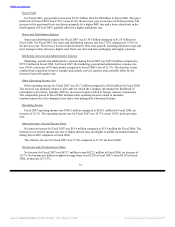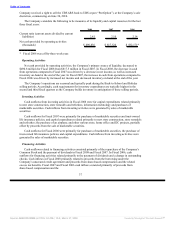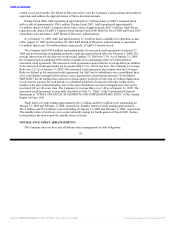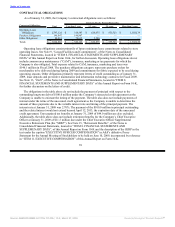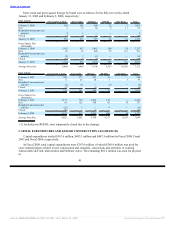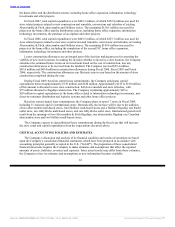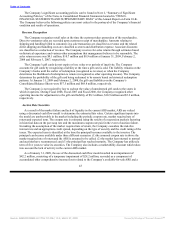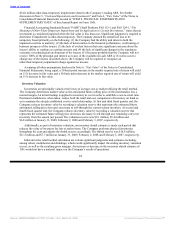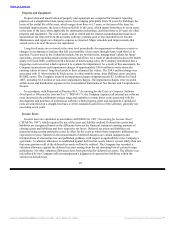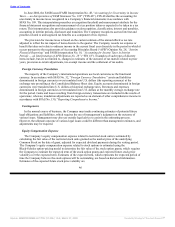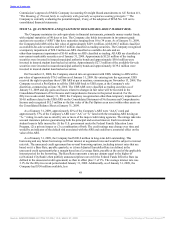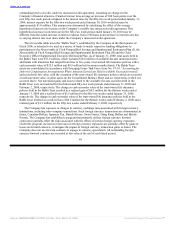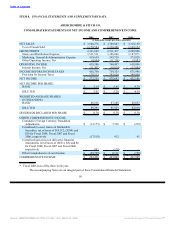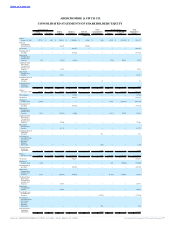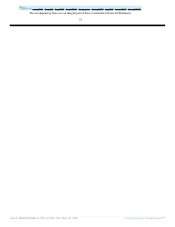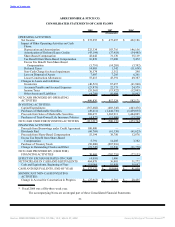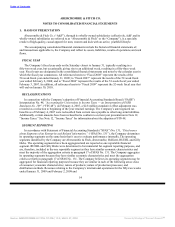Abercrombie & Fitch 2008 Annual Report Download - page 48
Download and view the complete annual report
Please find page 48 of the 2008 Abercrombie & Fitch annual report below. You can navigate through the pages in the report by either clicking on the pages listed below, or by using the keyword search tool below to find specific information within the annual report.
Table of Contents
Property and Equipment
Depreciation and amortization of property and equipment are computed for financial reporting
purposes on a straight-line basis, using service lives ranging principally from 30 years for buildings; the
lesser of the useful life of the asset, which ranges from three to 15 years, or the term of the lease for
leasehold improvements; the lesser of the useful life of the asset, which ranges from three to seven years,
or the term of the lease when applicable for information technology; and from three to 20 years for other
property and equipment. The cost of assets sold or retired and the related accumulated depreciation or
amortization are removed from the accounts with any resulting gain or loss included in net income.
Maintenance and repairs are charged to expense as incurred. Major remodels and improvements that
extend service lives of the assets are capitalized.
Long-lived assets are reviewed at the store level periodically for impairment or whenever events or
changes in circumstances indicate that full recoverability of net assets through future cash flows is in
question. Factors used in the evaluation include, but are not limited to, management’s plans for future
operations, recent operating results and projected cash flows. As a result of deteriorated sales in the fourth
quarter of Fiscal 2008, combined with a forecast of deteriorating sales, the Company determined that a
triggering event occurred, which required it to evaluate for impairment. As a result of this assessment, the
Company incurred non-cash impairment charges of approximately $30.6 million to write-down the
carrying values of stores’ long-lived assets to their estimated fair values. The $30.6 million charge was
associated with 11 Abercrombie & Fitch stores, six abercrombie stores, three Hollister stores and nine
RUEHL stores. The Company incurred an impairment charge of approximately $2.3 million for Fiscal
2007, including $1.6 million of non-store impairment charges. The impairment charges were recorded
within stores and distribution expense in the Consolidated Statements of Net Income and Comprehensive
Income.
In accordance with Statement of Position 98-1, “Accounting for the Costs of Computer Software
Developed or Obtained for Internal Use” (“SOP 98-1”), the Company expenses all internal-use software
costs incurred in the preliminary project stage and capitalizes certain direct costs associated with the
development and purchase of internal-use software within property, plant and equipment. Capitalized
costs are amortized on a straight-line basis over the estimated useful lives of the software, generally not
exceeding seven years.
Income Taxes
Income taxes are calculated in accordance with SFAS No. 109, “Accounting for Income Taxes”
(“SFAS No. 109”), which requires the use of the asset and liability method. Deferred tax assets and
liabilities are recognized based on the difference between the financial statement carrying amounts of
existing assets and liabilities and their respective tax bases. Deferred tax assets and liabilities are
measured using current enacted tax rates in effect for the years in which those temporary differences are
expected to reverse. Inherent in the measurement of deferred balances are certain judgments and
interpretations of enacted tax law and published guidance with respect to applicability to the Company’s
operations. A valuation allowance is established against deferred tax assets when it is more likely than not
that some portion or all of the deferred tax assets will not be realized. The Company has recorded a
valuation allowance against the deferred tax asset arising from the net operating loss of certain foreign
subsidiaries. No other valuation allowances have been provided for deferred tax assets. The effective tax
rate utilized by the Company reflects management’s judgment of expected tax liabilities within the
various tax jurisdictions.
45
Source: ABERCROMBIE & FITCH CO /DE/, 10-K, March 27, 2009 Powered by Morningstar® Document Research℠


